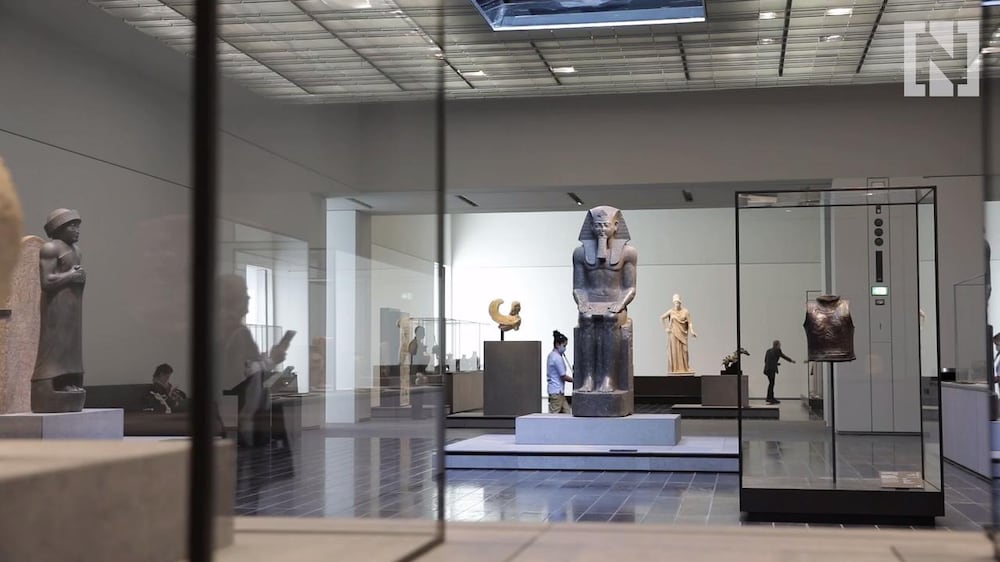You know you've made it as a tourist destination when newspapers like The New York Times run articles like "5 Pieces of Art You Should See at the Louvre Abu Dhabi."
As it did this week, as one among many. Monumental Statue with Two Heads, a haunting plaster figure from Jordan dating to around 6,500 BC, and one of the first things you see when you enter the permanent galleries, is the paper's number-one recommendation, followed by Page of the 'Blue Quran', one of the oldest ever and displayed alongside a Torah from Yemen, a Gothic Bible and Buddhist sutras.
Suddenly, for the outside world, Abu Dhabi has become much more interesting: a place with depth, in which to think and contemplate the world’s hardest questions as well as get away from it all, soak up the sun, play a round of golf and go for brunch.
![[©(c)Roland Halbe; Veroeffentlichung nur gegen Honorar, Urhebervermerk und Beleg / Copyrightpermission required for reproduction, Photocredit: Roland Halbe]](https://thenational-the-national-prod.cdn.arcpublishing.com/resizer/v2/GRS5DMYOHAIKUXG2PVJRQGPXVQ.jpg?smart=true&auth=81583f276d0ad69ed34dd2fa1086c92f2f5ca4e12cd05abcc3e605a204aae0d4&width=400&height=533)
“This has been a tourism strategy going back over a decade,” said Dr Jane Bristol-Rhys, an associate professor at Zayed University and specialist in the anthropology of tourism, who teaches Emirati and international studies and co-ordinates its masters in museum studies programme. “It started with the Formula One, which many people weren’t sure about at first but has been a huge success. Not everyone is interested in Bedouin culture, but a lot of people are interested in architecture, art and way cool buildings with modern designs.”
For the Department of Culture and Tourism, which says the number of international visitors to Abu Dhabi is predicted to reach 4.9 million this year, a 10 per cent rise on last year, tourism is part of a broader cultural strategy which now encourages visitors to see Unesco-listed and other archaeological sites in Al Ain, Qasr Al Hosn in Abu Dhabi and other local museums. It is hoped that the investment in the Louvre Abu Dhabi will support in sustainable tourism growth across the emirate from all over the world.
______________
Louvre Abu Dhabi
The five gifts Louvre Abu Dhabi offers to the UAE and the world
Louvre Abu Dhabi: the long-awaited first look inside
Louvre Abu Dhabi: the global critical response so far
______________
Several of Dr Bristol-Rhys’ former students are now working at Louvre Abu Dhabi, and she said she’s had dozens of excited messages from them this week, though their attention is already starting to turn to the still-pending Zayed National Museum, the Norman Foster-designed National Museum of the UAE which will also be located in the new cultural district.
In terms of what she has seen at the Louvre Abu Dhabi, Bristol-Rhys says she loves the locally-inspired design.
"And in terms of what is on show, the items themselves are gorgeous," she said.
"We are now in a new age of presentation in museums and I think they’ve been pretty bold. This is certainly not the Egyptian Museum in Cairo, where everything is shoved in a case, and it’s not the British Museum, which doesn’t have enough space.”
Nick Trend, deputy head of travel at The Daily Telegraph in London, who visited Louvre Abu Dhabi this week, said the building was an "extraordinary structure" which meant the UAE capital would now be seen as a more serious destination.

“It will be taken more seriously because it will appeal to a broader demographic - people who enjoy cultural attractions now have a much stronger reason to stop-over or stay longer," he said.
"I assume it will also pull tourists down from Dubai. The experience in Bilbao, Spain [the Guggenheim museum there just celebrated its 20 year anniversary] was that the new museum helped transform the city - not just for tourists, but for locals too.
"I don't think that the two cities are comparable, but I do think the museum will also help Abu Dhabi develop a stronger sense of its own identity.”
Dr Bristol-Rhys, too, said that despite the international interest, she predicts a high level of visits from UAE residents and Emiratis, as well as tourists.
“We will only now begin to look at what the changes have been in terms of who is coming here and where they are coming from," she said.
"It will be interesting to see what data the TCA (Abu Dhabi Tourism and Culture Authority) will collect but I think this museum will be very popular with UAE residents and Emiratis. It may change the demographic of the tourist population but whoever comes here is still going to need to have money - the hotels aren’t cheap.”
Mr Trend added: “I think it's a wonderful building and the artefacts are excellent; whether or not it really has a claim to a universal museum, and whether or not its visitors will be able to grasp high a concept when visiting for just a couple of hours is open to question. But all great cities have a world-class museum and an opera house, and Abu Dhabi just needs an opera house now.”






